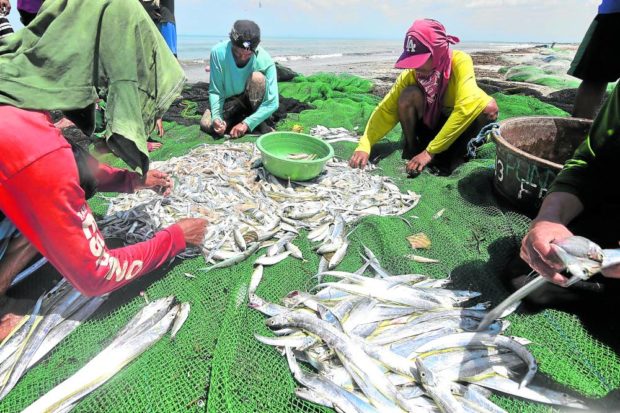Marine experts: Stop sandmining in Lingayen Gulf

FRESH CATCH In this photo taken in March, fishermen sort the day’s catch on the shores of Lingayen, Pangasinan. Coastal communities in the provinces of Pangasinan and La Union depend on the bounty of Lingayen Gulf to provide for their families. Their livelihood, however, is threatened by a proposed offshore black sand mining project that experts warn will harm the local marine environment. —WILLIE LOMIBAO
DAGUPAN CITY — Asserting that the proposed massive black sand mining in the waters off Pangasinan province threatens Lingayen Gulf, the University of the Philippines Marine Science Institute (UPMSI) added its voice to the growing clamor to stop the project that is seen to destroy a critical marine environment.
UPMSI said Lingayen Gulf, a major fishing ground with extensive mariculture activities that traverses both Pangasinan and La Union provinces, was at risk of suffering “irreversible” damage when the seabed was disturbed.
The project would only serve the “short-term interests of those who will profit from a misguided development that threatens the lifeblood of Pangasinan and La Union,” according to UPMSI, which maintains a marine science laboratory in Bolinao town in Pangasinan.
It said removing sediments offshore would deepen the seafloor, which could produce stronger waves reaching the coast and worsen flooding, especially during typhoon season. “Hence, the coastal area becomes more vulnerable to both man-made and natural disasters,” UPMSI said in a statement on Monday.
A project of Iron Ore, Gold and Vanadium Resources (Phils.) Inc., the offshore magnetite mining proposed to extract 25 million tons of black sand yearly for 25 years, targeting to start by the second half of 2022.
Article continues after this advertisementECC application
The Quezon City-based company applied for an environmental compliance certificate (ECC) from the Environmental Management Bureau (EMB) in August, based on records from the Department of Environment and Natural Resources.
Article continues after this advertisementMalacañang approved the project on Nov. 25, 2020, under Financial or Technical Assistance Agreement No. 07-2020-IOMR. The agreement allows the company to conduct large-scale exploration, development and commercial utilization of minerals found within the areas it obtained the exclusive rights to extract magnetite sand.
In September, a series of virtual public scoping was held by the EMB in areas whose territorial waters are covered by the project.
Spanning 9,252.45 hectares or 92.5 square kilometers, the project area will cover a major aquaculture center of the gulf off the coast of the Pangasinan towns of Labrador, Lingayen, Binmaley and San Fabian, and Dagupan City.
Fishing communities
But UPMSI said mining activities would also affect Hundred Islands National Park in the western side of the gulf and Agoo-Damortis Protected Landscape and Seascape in the east. Bolinao-Anda Reef Complex, which supports Lingayen Gulf, is also in danger of being damaged by the project.
Citing data from the Bureau of Fisheries and Aquatic Resources (BFAR), UPMSI said over 1.2 million people lived in towns and cities facing the gulf, which had been classified as an environmentally critical area in 1993 by then President Fidel Ramos through Proclamation No. 156.
In 2020, a total of 47,435 people were engaged in fisheries and its related activities in Pangasinan and La Union, the research institute said. These included capture fishing, aquaculture, gleaning, fish processing, among others.
“Any intense extractive and manipulative activities in Lingayen Gulf could severely affect the fisheries that thrive on ecosystems in the gulf as well as the livelihood of fishing families there,” UPMSI said.
The gulf is home to diverse and interconnected ecosystems where 40 species thrive, including mackerel, round scads and rabbitfish.
Data from the BFAR also showed that the fish yield from the gulf in 2019 reached 16,280 metric tons (worth P1.7 billion) in Pangasinan and 3,602 MT (P458 million) in La Union.
The mariculture parks in the gulf also produced 58,273 MT (P6.7 billion) in 2019 for both Pangasinan and La Union.
Fisherfolk group Pamalakaya, community organizations and local officials in the two provinces have also been protesting the project due to what they described as “devastating” impact on the environment.